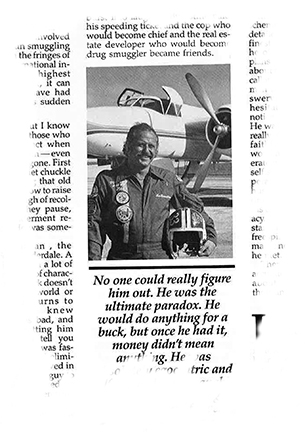Ken Burnstine Is Still Dead — 42 Years Later

It has been 42 years since the World War II vintage P-51 fighter plane crashed in flames in the Mojave Desert of California. And almost that long since Gold Coast magazine assured the world that Ken Burnstine was really dead. He still is, 36 years later. And yet his legend lives on. Gaeton Fonzi’s book-length report, which appeared in three issues early in 1982, has proved to be the most enduring story in Gold Coast’s 53-year history. For more than a decade we have been getting requests for copies of that story. They usually come from someone with a personal interest in Ken Burnstine, an Ivy League educated, former Marine Corps officer, and prominent-developer-turned-big-time-drug-smuggler. How big? Burnstine died under mysterious circumstances while practicing for an air race, shortly before he was to testify against more than 70 associates in a massive drug running operation.
One of the requests a few years back came from a relative of a pilot who died in the crash of one of Burnstine’s planes. The man hoped the story might somehow show that his uncle was an innocent party, unaware that the plane he flew was a smuggling machine. Alas, he must have been disappointed. Burnstine’s pilots had to know what they were doing, loading up with drugs in the islands and Central America and flying at night on carefully planned routes to avoid radar and find secret landing spots around Florida. It was dangerous and illegal work, but they were well paid for it. And so were Burnstine’s investors, who doubled their money in a matter of days.
The most recent request, just this month, came from a man who said he was related to Burnstine. He is active military, suggesting he probably is too young to have known Burnstine. But he had heard about the articles and wanted to read them. Unfortunately, copies of those 1982 issues are few, but we had copied the pages for just such requests.
Burnstine was as colorful as the wildly painted P-51 he owned. That plane was his recreation. He had an enormous ego and loved attention, even bad publicity. He was often in the news for such things as keeping a lion in his home. Many people knew he was smuggling drugs for years before he got caught. Planes he owned were crashing filled with dope. People wondered how he got away with it. But at the time of his death he had been convicted and had turned government informant. His testimony at an upcoming trial could have sent dozens of South Florida people, some of them well known, to jail.
Fonzi’s story ended a myth that was even reported by the papers, that Burnstine had faked his death, that only a thumb was found in the plane’s wreckage, and that he was living the good life in Europe. Even today there are people who, if they remember Burnstine at all, suspect he evaded prison and is growing old somewhere with a missing hand. But Fonzi’s story quoted the coroner to the effect that more than just his thumb was found. His skull and teeth and the rest of his dismembered and charred body were also identified. Thus the title: “Ken Burnstine is
Still Dead.”
More dramatically, Fonzi revealed that there was a suspicion that his plane had been sabotaged with a motion activated bomb, which exploded when he showed off by rolling his plane at low altitude. Death prevented him from testifying against the many associates who backed his smuggling enterprise.
Moreover, Fonzi turned up information that even Burnstine’s closest friends did not know. He revealed that in the Marine Corps Burnstine was not a flier; he was a intelligence officer. Furthermore, for years he had some sinister CIA contacts. Fonzi, one of the best investigative reporters of his time, knew a lot about the CIA. He worked for five years for two government committees that had reopened the investigation of President John F. Kennedy’s death. He had connections beyond the scope of that work, which served him well when researching Burnstine’s murky past.
He learned that one man he was scheduled to testify against in the drug case was a supplier of arms to anti-communist Latin American groups. Fonzi wondered if one reason Burnstine avoided prosecution for so long was that he enjoyed protection by serving the government in some clandestine capacity. He interviewed Burnstine’s principal intelligence connection, who told him they had been good buddies, but had a falling out. It is obvious why. Burnstine could send him to jail. The connection also happened to be a specialist in sophisticated weapons, including devices designed to kill silently. Was one of those devices used to destroy an airplane and the notorious figure flying it?
We likely will never know. What we do know is that after 42 years, Ken Burnstine is still dead. And some people still care about his story. He would be thrilled.

KEN BURNSTINE
This Comment had been Posted by Michael O’Leary
Dear Mr. McCormick, Is it possible to purchase the three-part article on Ken Burnstine? I knew him slightly from air racing and he was an unusual character. Regards, Michael O’Leary